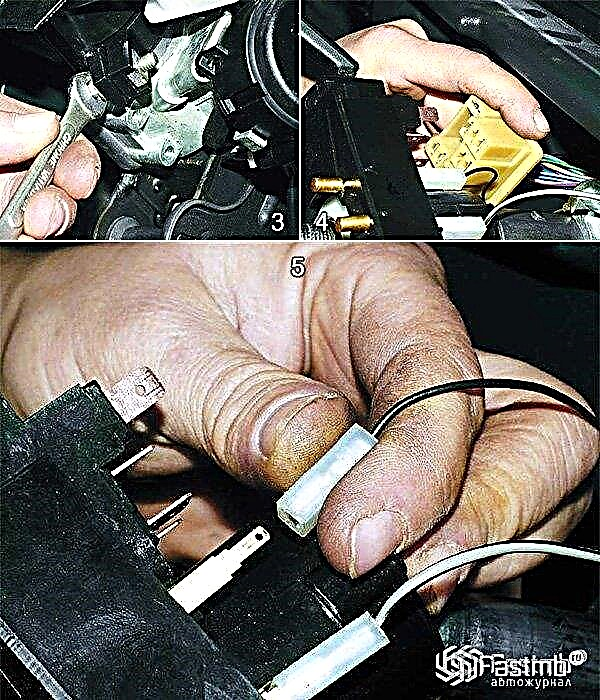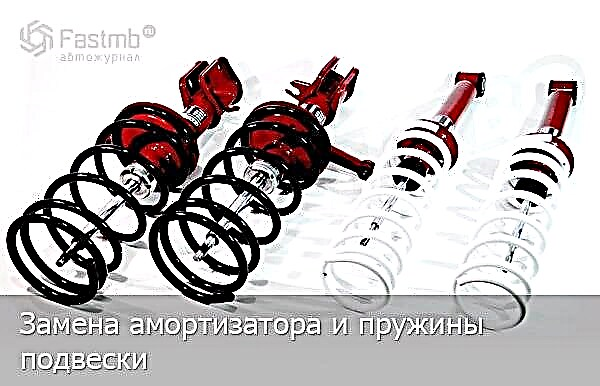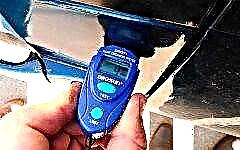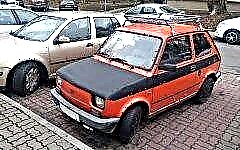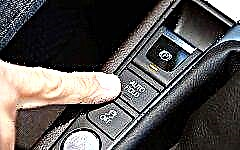

The content of the article:
- The structure and main functions of the brake
- Highlights of the Electromechanical Parking Brake System
- Disadvantages and Benefits
- Features of car operation with EPBS
The manual braking system of a car, which keeps the car from rolling forward or backward while it is stopped in the parking lot, is an important component of any vehicle.
In modern models, the classic parking brake familiar to motorists, based on a mechanical principle of operation, has been replaced by a more convenient and advanced mechanism with electronic elements (Electromechanical Parking Brake System, or EPB for short).
Let's figure out how the functioning of this mechanism differs and how to properly operate it.
Design and main functions of the electromechanical parking brake

The photo shows the electric parking brake device
- brake disk;
- brake shoe;
- movable bracket;
- reducer;
- electric motor;
- power supply;
- gear wheel of the electric motor;
- electric motor;
- drive pinion;
- swinging gear;
- driven gear of the electric drive
The main purpose of the device is to provide the following actions:
- in a situation where the machine is stopped, hold it in place, not allowing it to roll on an incline;
- in a situation where the main braking system has broken down, take over its functions and perform an emergency stop of the vehicle;
- in a situation where the car starts after suspension on the rise, prevent the car from rolling back.
Electromechanical Parking Brake System includes the following system units:
- directly the braking system;
- electric drive system;
- control system based on an electronic circuit.
The braking system is a disc brakes known to everyone since the forties of the last century. They are efficient, cool well and do not lose their stopping power when overheated, and they are also highly resistant to dirt and moisture.
The electric drive of the system is a single unit, which, using a belt-type transmission, sequentially imparts a motor impulse to the gearbox and the screw-type drive.

In the photo, the gearbox of the electromechanical parking brake
- 1 - driven shaft;
- 2.5 - leash;
- 3 - drive pinion;
- 4 - swinging gear;
- 6 - driven gear
The gearbox is responsible for reducing the noise of the mechanism and relieves the screw drive from unnecessary load, which, in turn, activates the translational movement of the braking piston.
The electronic control system, which is part of the technical unit, includes sensors for determining external data, a central control unit and command execution mechanisms. Signals to the input of the control system can come from various sources:
- from the clutch sensor, which is responsible for fixing the clutch pedal and the speed of its release;
- from the vehicle position sensor (sensor for determining the angle of inclination), located directly in the electronic control unit of the system;
- from the button for activating the handbrake operating mode, located on the main console of the car.

The photo shows a diagram of the operation of the electromechanical parking brake in 2 positions a) tightening the brake b) removing the brake
- 1 - brake disc;
- 2 - push nut;
- 3 - lead screw;
- 4 - reducer;
- 5 - the piston of the brake mechanism;
- 6 - cylinder;
- 7 - a sealing ring;
Receiving signals from the listed sources, the electronic brake control system gets the ability to directly interact with the vehicle stability control system and other engine control systems.
- Also Read How To Choose Good Brake Lines
- Related article: How to check the braking system of a car
Highlights of the Electromechanical Parking Brake System

In order to turn on the Electromechanical Parking Brake System, you must activate it by pressing a button on the central control panel of the car. At this point, the brake electric motor pushes the brake pads towards the disc, and the brake disc itself is rigidly fixed.
The second option for activating the electronic handbrake is to press the corresponding button, provided that the brake pedal is already depressed.
By pressing a button, the system is activated provided that the following points are fulfilled: if the ignition is off, the seat belt is unfastened in the driver's seat and the driver's door is not closed.
In order to turn off the brake at the moment the car starts, you do not need to do separate actions: the electronics itself will turn it off at the moment the vehicle starts moving. With such a disconnection, the electronic control unit of the control system analyzes a number of indicators from its sensors:
- the angle of inclination of the machine relative to the reference horizontal surface;
- the direction of the slope of the car;
- clutch pedal level;
- acceleration and speed at which the pedal is released;
- gas pedal position.
Thanks to the analysis of these data, the electromechanical parking brake can be disengaged at the start with a different delay interval, thereby preventing such a "terrible" moment for students of driving schools when, after stopping on a surface with a backward slope, there is a risk of not pressing the pedal, and the car will spontaneously roll backward, pushing too "pressed" him on the hill, the car.
It should be said that not only students, but also novice drivers, and even those who already have quite solid driving experience, but rarely encountered the peculiarities of driving on slopes, can get into such situations.
The electromechanical parking brake is also very useful for vehicles with automatic transmission. In such models, together with the EPB activation button, as a rule, they also place an Auto Hold button for activating the auto hold mode, which is responsible for the automation, which allows the car to be held in place during a short stop.
This useful function is extremely relevant when driving in the city cycle, which is replete with constant short-term stops at intersections and traffic lights, as well as when driving in traffic jams.
The activated Auto Hold button allows the driver not to apply the brakes after the vehicle stops moving. It is important to remember that this mode is enabled only if:
- the door on the driver's side is closed;
- the driver's seat belt is fastened;
- the engine is running.
There is another extremely useful EPB function: if the car is stopped for a long period of time, the system is activated independently, without the participation of the car enthusiast.
Also, the system will turn itself on if the driver does not have a seat belt fastened when the ignition is on, one of the passenger compartment doors or the trunk is open. In this way, EPB improves vehicle safety.
- Read also, why brake with the engine?
Disadvantages and advantages of the electromechanical parking brake in comparison with the classic "handbrake"

The photo shows an electromechanical parking brake versus a manual one
Cons of an electromechanical parking brake:
- first of all, cars equipped with an electronic version of the hand brake have a higher cost;
- EPB does not provide brake force adjustment, which makes it inconvenient for those who are accustomed to such adjustment when using a classic mechanical brake;
- if the car battery is completely discharged, it is impossible to turn off the EPB, it will be possible to get under way only by charging the battery and supplying power to the EPB;
- in case of failure, the repair of the unit will cost a pretty penny.
With all of these shortcomings, EPB-equipped cars are gaining more and more popularity. There are many reasons for this.
Pros of an electromechanical parking brake:
- the car is securely fixed in a variety of situations, when a motorist can forget about the need to activate the classic mechanical "handbrake";
- a car with an electronic brake does not roll back at the start if the car is going uphill;
- when starting the car, you do not need to remember about the need to remove it from the parking brake - the EPB turns off automatically, and even with the analysis of the tilt angle;
- the brake turns on very easily - no need to apply unnecessary efforts, as is the case with the classic "mechanics";
- Unlike the mechanical parking brake, the electronic brake does not need to be adjusted;
- a bulky lever next to the driver's seat replaces a small button on the control panel, which gives the cabin a more aesthetic appearance and leaves more room next to the driver's seat.
What to look for
- In order not to doubt the reliability of the system, it is necessary to systematically check the system at a specially equipped stand in the service station with the system specified in the passport to the device.
- If there is a need to hand over the car for repair, you should remember about the need to first transfer the system to the service mode. Otherwise, the electronic module may accidentally activate during the repair process and cause additional damage to the machine.
Features of operating a car with an electromechanical parking brake: tips for motorists

- When driving on a short downhill slope, parking or activating reverse movement, it is better to turn off the EPB mode.
- But in the case of driving on a long descent, the Auto Hold mode turned on, although it will force you to drive with constant braking, will not allow the car to accelerate to an uncontrolled state.
- On slippery roads, owners of cars with an automatic transmission are advised to always keep the Auto Hold button on. Also, this mode will help when climbing an icy hill.
- If the car starts to move with the EPB on, you need to carefully squeeze out the gas so that the engine speed increases gradually, and the movement occurs smoothly and without jerks.
- It is not worth keeping the car on the electronic parking brake for a long time - from prolonged use the battery can "sit down", and then it will be problematic to turn off the mode.
It is not worth getting carried away with using EPB, ignoring the main brakes. First, the parking brake only works on the rear wheels of the vehicle. Secondly, even with all its "intelligence", it is able to provide the car with only a third of the power of its general braking system.
- Find out how to diagnose brake failure
The presence of EPB in the design greatly simplifies driving in traffic jams and starting the car when driving uphill, and also eliminates the problem of forgetfulness, which is common among novice motorists, when a car starts moving with the "handbrake" on.
It should not be forgotten that, like any electronics, this device is expensive to buy and to repair, and also requires knowledge of a number of additional nuances of driving.
- Related article: 10 facts about the braking system

